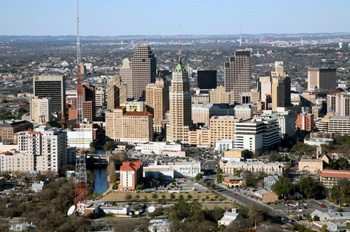 San Antonio is the city in Texas, United
States. The city is noted for its mixture of Spanish, Mexican, and
Anglo-American cultures and is the site of the famous Alamo fortress.
San Antonio is the city in Texas, United
States. The city is noted for its mixture of Spanish, Mexican, and
Anglo-American cultures and is the site of the famous Alamo fortress.
One of the largest cities in the United States, San Antonio is a commercial, manufacturing, military, tourist, and financial centre situated in a crop-farming and cattle- and sheep-farming region. It produces chemicals, processed foods, building materials, aerospace equipment, clothing, and machinery. Five military installations, including four US Air Force bases, within or just outside the city are important to its economy.
Among the many points of historical interest in San Antonio are five Franciscan missions, including Mission San Antуnio de Valero (founded 1718), which after 1793 was converted into a fortress known as the Alamo (Sp., “cottonwood tree”). Also of note are the Spanish Governor's Palace, which in 1772 became the headquarters of the Spanish government in Texas and La Villita, a complex of some two dozen restored buildings on the site of a Coahuiltecan village; San Fernando Cathedral (completed 1873); the King William Historic District, a residential area settled in the late 19th century by merchants from Germany; and the tall Tower of the Americas, built for HemisFair '68, a world's fair held in San Antonio in 1968. Sea World of Texas and a musical theme park are also located here.
Institutions of higher education in San Antonio include Trinity University (1869), the University of Texas at San Antonio (1969), the University of Texas Health Science Center at San Antonio (1976), St Mary's University of San Antonio (1852), Incarnate Word College (1881), and the Oblate School of Theology (1903). Cultural facilities include the Marion Koogler McNay Art Institute, the Institute of Texan Cultures and Lone Star Hall of Texas History, and the San Antonio Museum of Art. The city of San Antonio supports a symphony orchestra and is the site of an annual opera festival.
The site of San Antonio was long inhabited by Native Americans of the Coalhuiltec and Payaya tribes. The first permanent European settlement was established in 1718, when the mission of San Antуnio de Valero and the presidio (fortress) of San Antуnio de Bйjar (Bйxar) were built here by the Spanish. Four other missions were soon constructed nearby and a community, called San Fernando de Bйxar, was laid out in 1731 by 15 immigrant families from the Canary Islands. The settlement developed as the major Spanish, and after 1821, Mexican, stronghold in Texas until the struggle for Texan independence, when San Antonio was captured by Texans in December 1835. It remained under their control until March 6, 1836, when Mexican soldiers under the leadership of General Antonio Lуpez de Santa Anna stormed the Alamo and massacred 187 Texans, including the frontiersmen Davy Crockett and Jim Bowie.
After the American Civil War and the arrival of the railway in 1877, San Antonio developed as a cattle market and distribution point for south-central Texas. It prospered as a military centre during both world wars. San Antonio's population increased markedly from the 1940s, in part through the annexation of adjacent communities. Population (1980) 786,023; (1990) 935,933.
Microsoft Encarta 97 Encyclopedia. 1993-1996 Microsoft Corporation